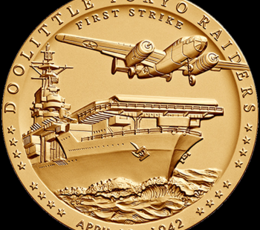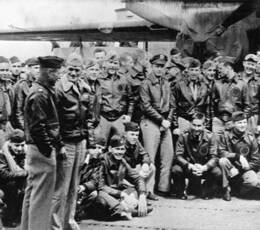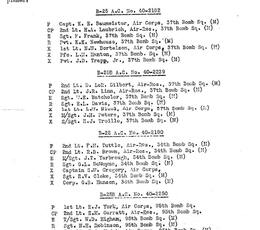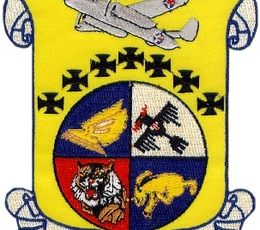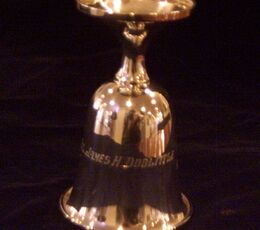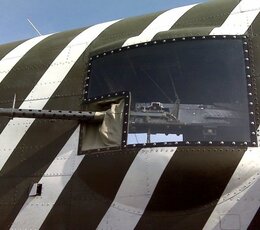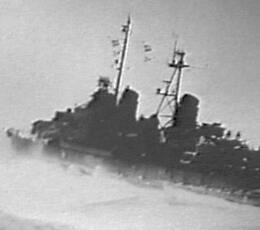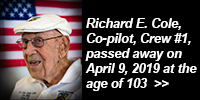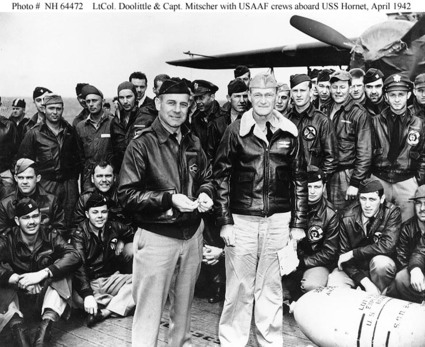
This web site is dedicated to the 80 Brave Men who participated in the Doolittle Tokyo Raid on April 18th, 1942, taking off from the aircraft carrier USS Hornet on a secret mission to bomb the Japanese Mainland for the first time in history. This site is also a tribute to all the service personnel who helped these 80 men including reserve crews, Navy personnel on the Task Force, and also to all who have helped with the Reunions each year including the Escorts, the entire Air Force and each years Sponsor for the Reunions.
The Raid was a total secret to all involved and the members of the raid were chosen by volunteering for a "dangerous secret mission". The members did not know the target destination until the planes were loaded onto the ship and the raid was underway. This was to prevent any "leakage" of information about the raid. 16 B-25 twin engine bombers were to take off from the deck of the Aircraft Carrier USS Hornet and bomb Japan mainland. This would be the first attack on Japanese mainland of WW2. Because the airplanes were too large to be taken below deck on the aircraft carrier they had to be stored at the end of the runway on top. As a result the runway was very short, especially for the first plane in line, and special training was required to teach the pilots to be able to take off in such a short distance with a full payload.
April 18, 1942 - About 600 miles from Japan mainland a small fishing boat was spotted and destroyed and General Doolittle felt that this small boat may have warned Japan that there is a big ass US Aircraft Carrier just outside of town... So Jimmy Doolittle ordered the raid to proceed immediately. As a result of the early take-off the planes would be short on fuel to reach the "Safe Zones" in nearby China despite desperate measures taken to prepare the planes in advance by engineers to give them the maximum amount of fuel storage space available including removing the tail gunner section and installing broomsticks painted like machine guns and placing a rubber fuel tank in the tail section, carrying ten 5 gallon gas cans for manual fuel addition during flight to a tank installed where the lower gun turret was, and a larger tank located in the bomb bay. Total fuel payload was 1,141 Gallons for a 2000 mile range.
Due to the possibility of detection by the small boat the raid was ordered to proceed ahead of schedule and aircraft takeoff was to begin immediately. The planes now had about enough fuel to successfully reach the landing zones - if they flew straight to them without errors in navigation or using evasive maneuvers.
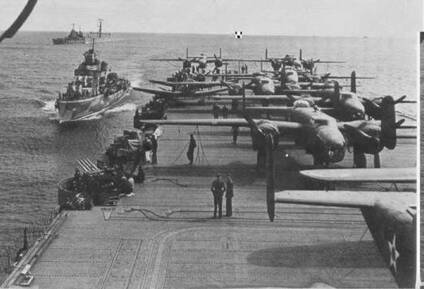 All 16 B-25's successfully took off from the Carrier and bombed their targets. Most planes encountered anti-aircraft fire and some encountered enemy interception in the air. All of the airplanes except one either crash landed or the crew bailed out. The plane that did land, landed in Russia and the crew were internees. After being held captive with liberal freedoms available an escape attempt was executed to Iran and British Consul helped the men back to the US on May 29, 1943 - Over a year after the raid.
All 16 B-25's successfully took off from the Carrier and bombed their targets. Most planes encountered anti-aircraft fire and some encountered enemy interception in the air. All of the airplanes except one either crash landed or the crew bailed out. The plane that did land, landed in Russia and the crew were internees. After being held captive with liberal freedoms available an escape attempt was executed to Iran and British Consul helped the men back to the US on May 29, 1943 - Over a year after the raid.
The B-25 raid on Japan has gone down in the annals of World War II as a classic example of the courage and ingenuity of American airmen in combat. Led by the incomparable Jimmy Doolittle, the raid came at a time when the Japanese were advancing steadily across the Pacific. Guam, Wake, Hong Kong, and Singapore had fallen. In the Philippines, General Wainwright and the remnants of his force were making a brave but hopeless last stand on the Corregidor.
The appearance of 16 B-25s over Japan on April 18, 1942, lifted the gloom that had descended upon America and her Pacific allies. The bomb damage that resulted was not great, compared with that inflicted later in the war, but the raid had some far-reaching effects. The Japanese were forced to retain fighter units for the defense of the home islands which had been intended for the Solomons, and they felt compelled to expand their Pacific perimeter beyond the area where it could be defended adequately. The full impact of the raid on the minds of the Japanese military leaders and its consequent influence on the course of the war in the Pacific were not realized until long after that conflict.
For American and her allies the raid was a badly needed morale booster. Besides being the first offensive air action undertaken against the Japanese home islands, the Tokyo raid accomplished some other "firsts" that augured well for the future. It was the first war action in which the United States Army Air Force and the United States Navy teamed up in a full-scale operation against the enemy. The Doolittle Raiders were the first and last to fly land-based bombers from a carrier deck on a combat mission and first to use new cruise control techniques in attacking a distant target. The incendiary bombs they carried were the forerunner to those used later in the war. The special camera recording apparatus developed at Colonel Doolittle's request was adopted by the AAF and the crew recommendations concerning armament, tactics and equipment were used as the basis for later improvements.
It was twenty-six months before American bombers went back to Japan. During those months of bitter fighting, America was slowly building her land, sea and air forces and with them driving the enemy, island by island, back across the Pacific. In 1944 and 1945 mighty fleets of B-29s penetrated the skies over Japan and finished the job begun by Jimmy Doolittle and the Tokyo Raiders in April of 1942.

